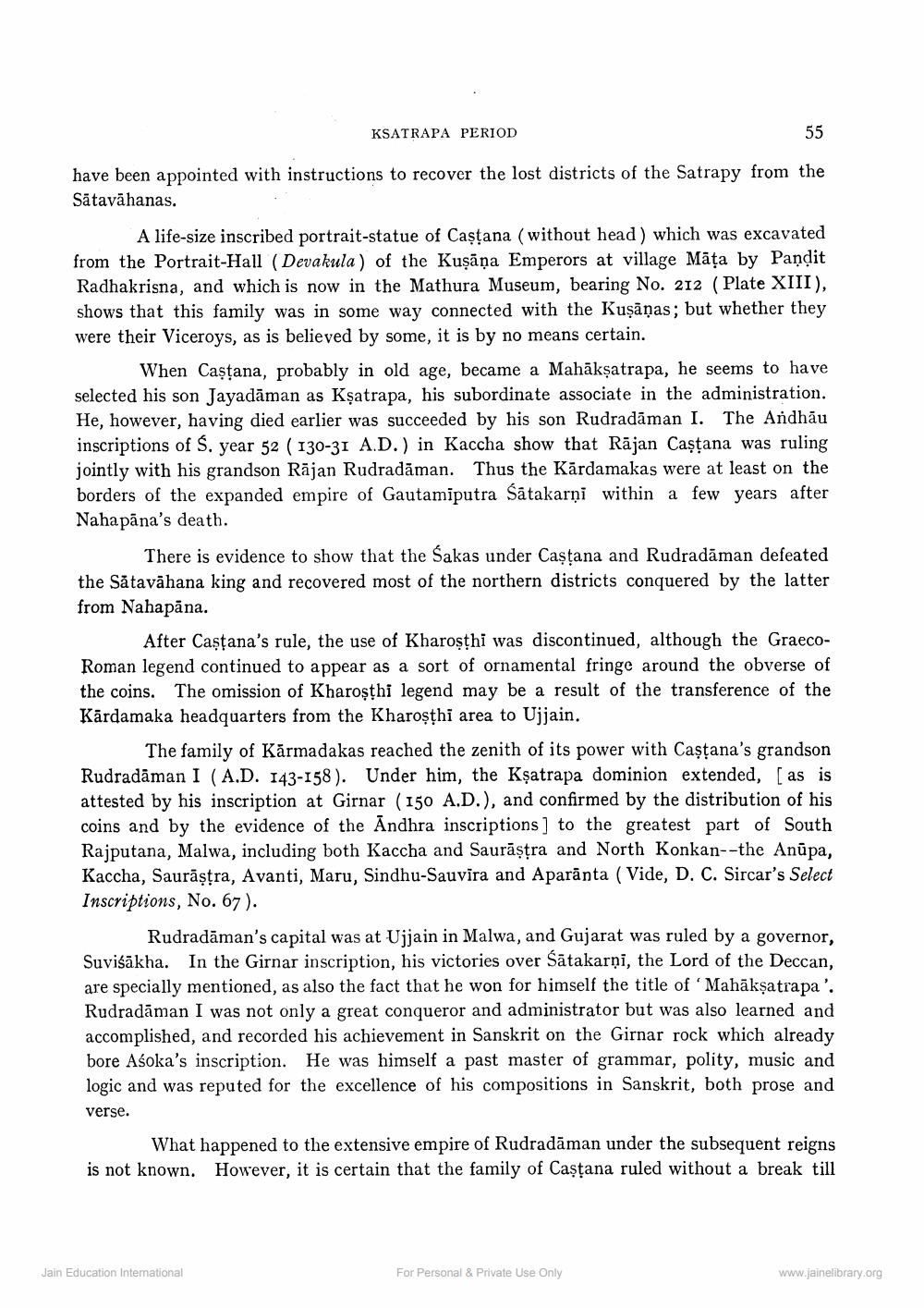________________
KSATRAPA PERIOD
55
have been appointed with instructions to recover the lost districts of the Satrapy from the Sātavāhanas.
A life-size inscribed portrait-statue of Castana (without head) which was excavated from the Portrait-Hall (Devakula) of the Kuşāņa Emperors at village Māța by Pandit Radhakrisna, and which is now in the Mathura Museum, bearing No. 212 (Plate XIII), shows that this family was in some way connected with the Kuşāņas; but whether they were their Viceroys, as is believed by some, it is by no means certain.
When Caştana, probably in old age, became a Mahākṣatrapa, he seems to have selected his son Jayadāman as Kşatrapa, his subordinate associate in the administration. He, however, having died earlier was succeeded by his son Rudradāman I. The Andhāu inscriptions of $. year 52 ( 130-31 A.D.) in Kaccha show that Rājan Cașțana was ruling jointly with his grandson Rājan Rudradāman. Thus the Kārdamakas were at least on the borders of the expanded empire of Gautamiputra Śātakarņi within a few years after Nahapāna's death.
There is evidence to show that the Sakas under Castana and Rudradāman defeated the Sātavāhana king and recovered most of the northern districts conquered by the latter from Nahapāna.
After Castana's rule, the use of Kharosthi was discontinued, although the GraecoRoman legend continued to appear as a sort of ornamental fringe around the obverse of the coins. The omission of Kharoșthi legend may be a result of the transference of the Kārdamaka headquarters from the Kharoșthi area to Ujjain.
The family of Kārmadakas reached the zenith of its power with Caştana's grandson Rudradāman I (A.D. 143-158). Under him, the Ksatrapa dominion extended, [as is attested by his inscription at Girnar (150 A.D.), and confirmed by the distribution of his coins and by the evidence of the Andhra inscriptions] to the greatest part of South Rajputana, Malwa, including both Kaccha and Saurāșțra and North Konkan--the Anūpa, Kaccha, Saurāṣtra, Avanti, Maru, Sindhu-Sauvira and Aparānta (Vide, D. C. Sircar's Select Inscriptions, No. 67).
Rudradāman's capital was at Ujjain in Malwa, and Gujarat was ruled by a governor, Suviśākha. In the Girnar inscription, his victories over Śātakarņi, the Lord of the Deccan, are specially mentioned, as also the fact that he won for himself the title of 'Mahākṣatrapa'. Rudradāman I was not only a great conqueror and administrator but was also learned and accomplished, and recorded his achievement in Sanskrit on the Girnar rock which already bore Asoka's inscription. He was himself a past master of grammar, polity, music and logic and was reputed for the excellence of his compositions in Sanskrit, both prose and verse.
What happened to the extensive empire of Rudradāman under the subsequent reigns is not known. However, it is certain that the family of Cașțana ruled without a break till
Jain Education International
For Personal & Private Use Only
www.jainelibrary.org




